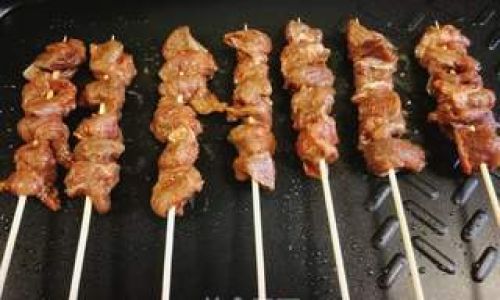Introduction
Barbecue, or BBQ as it’s commonly abbreviated, is a culinary art form that transcends cultural boundaries. From the smoky flavors of American pitmasters to the fiery spices of Korean galbi, the versatility and appeal of barbecue are unparalleled. Whether you’re hosting a backyard gathering, tailgating at a sports event, or simply craving a hearty meal, mastering the art of barbecue can elevate your culinary skills and delight your taste buds. This comprehensive guide will walk you through the essentials of how to make barbecue, from selecting the right equipment and ingredients to perfecting cooking techniques and creating delicious sauces and sides.

Chapter 1: Choosing the Right Equipment
The foundation of any successful barbecue is having the right tools and equipment. While some may argue that simplicity is key, others swear by elaborate setups. Ultimately, your choice will depend on your personal preferences, budget, and the type of barbecue you plan to cook.
1 Grills and Smokers
-
Charcoal Grills: Charcoal grills offer a classic, smoky flavor that’s hard to replicate with other methods. They come in various sizes, from portable tabletop models to large, stationary units. When using a charcoal grill, consider investing in a chimney starter for easy, safe coal ignition.
-
Gas Grills: Gas grills are convenient and offer consistent heat, making them ideal for quick cooking sessions. Look for models with adjustable burners for better temperature control.
-
Smokers: For true barbecue aficionados, a smoker is a must-have. These devices allow for low-and-slow cooking, which is crucial for tender, flavorful meats. Smokers can be fueled by charcoal, wood, electricity, or propane.
-
Pellet Grills/Smokers: Pellet grills combine the convenience of gas with the smoky flavor of wood. They use compressed wood pellets as fuel and offer precise temperature control.
2 Tools and Accessories
-
Tongs and Spatulas: Essential for flipping and transferring meats without piercing them, which can release juices.
-
Meat Thermometers: A reliable meat thermometer is crucial for ensuring your food is cooked to a safe internal temperature. Instant-read thermometers are particularly useful.
-
Grill Brushes: Keep your grill grates clean with a sturdy wire brush. A scraper can also be helpful for removing stubborn residue.
-
Gloves and Aprons: Heat-resistant gloves and aprons protect you from burns and splatters.
-
Basting Brushes: For applying sauces and marinades evenly during cooking.
-
Wood Chips and Chunks: For adding smoke flavor to your barbecue. Different woods (e.g., oak, hickory, apple) offer distinct flavors.
Chapter 2: Selecting and Preparing Ingredients
The quality of your ingredients is paramount to the success of your barbecue. Choose meats that are fresh, well-marbled, and suitable for slow cooking. Don’t overlook the importance of vegetables and sides, which can complement your main dishes beautifully.
1 Meats
-
Beef: Look for cuts like brisket, ribs, and chuck roast, which are rich in fat and collagen, making them ideal for long, slow cooking.
-
Pork: Pork shoulder (also known as butt), pork ribs, and pork belly are popular choices. They become tender and flavorful when cooked low and slow.
-
Chicken: Whole chickens, chicken parts, and turkey can all be barbecued. Smaller pieces cook faster and are easier to manage on the grill.
-
Lamb: Lamb shoulder and leg are great for barbecue, offering a rich, gamey flavor.
-
Sausage:Bratwurst, chorizo, and other types of sausage can add variety to your barbecue spread.
2 Marinades and Seasonings
-
Marinades: Marinades tenderize meat and add flavor. Common ingredients include acids (like vinegar or lemon juice), oils, herbs, and spices. Marinate for at least a few hours, preferably overnight.
-
Dry Rubs: A blend of spices, sugars, and salts applied directly to the meat before cooking. They create a crispy exterior and flavorful crust.
-
Wet Rubs: Similar to marinades but thicker in consistency, wet rubs are applied just before cooking. They often contain ingredients like ketchup, mustard, brown sugar, and spices.
3 Sauces
-
BBQ Sauce: The quintessential barbecue sauce is typically a blend of tomatoes, vinegar, sugar, molasses, and spices. Adjust the sweetness, tanginess, and spice level to your taste.
-
Mustard Sauce: Eastern North Carolina-style barbecue often features a tangy mustard-based sauce. It’s made with mustard, vinegar, sugar, and a touch of cayenne.
-
Vinegar Sauce: South Carolina’s signature sauce is a simple mix of vinegar, pepper, and sometimes a bit of sugar or ketchup.
-
Other Sauces: Experiment with variations like honey mustard, molasses-based, or even fruit-infused sauces to suit your preferences.

Chapter 3: Cooking Techniques
The cooking process is where the magic happens. Different techniques yield varying results, so it’s important to understand the basics and experiment to find what works best for you.
1 Direct Grilling
Direct grilling involves placing food directly over the heat source. It’s best suited for quick-cooking items like steaks, burgers, and vegetables. Use high heat to sear the exterior and lock in juices.
2 Indirect Grilling
Indirect grilling involves setting up one side of the grill for direct heat and the other for indirect heat. This method is ideal for low-and-slow cooking, such as with brisket, pork shoulder, or whole chickens. Place the meat on the indirect heat side, with the lid closed, to allow for even cooking and smoke penetration.
3 Smoking
Smoking is a slow cooking process that uses indirect heat and wood smoke to flavor and tenderize meat. It requires a smoker or a grill modified for smoking. Maintain a low temperature (around 225-250°F) and add wood chips or chunks as needed to maintain smoke.
4 Monitoring and Adjusting
-
Temperature Control: Keep a close eye on the grill or smoker temperature. Adjust vents or burners as necessary to maintain the desired cooking temperature.
-
Moisture Management: Use a water pan in your smoker to help maintain humidity and prevent the meat from drying out.
-
Flipping and Rotating: Turn meats occasionally to ensure even cooking. With larger cuts, rotate them 180 degrees halfway through to promote even heat distribution.
Chapter 4: Creating Side Dishes and Desserts
No barbecue is complete without a selection of delicious sides and desserts. These dishes not only complement the main courses but also provide a well-rounded meal experience.
1 Classic Sides
-
Cornbread: A staple at many barbecues, cornbread can be sweet or savory, depending on your preference.
-
Beans: Baked beans, pinto beans, or black beans can be seasoned with barbecue sauce, bacon, and onions for a hearty side dish.
-
Potato Salad: A creamy or vinaigrette-based potato salad adds a refreshing touch to your meal.
-
Coleslaw: A tangy, crunchy coleslaw pairs perfectly with smoky meats.
-
Pickles and Relishes: Homemade pickles, pickled jalapeños, or fruit relishes add a burst of flavor and acidity.
2 Unique Sides
-
Grilled Vegetables: Bell peppers, onions, zucchini, and corn can be grilled and served with a drizzle of olive oil and herbs.
-
Corn on the Cob: Grilled or smoked corn on the cob with butter, salt, and pepper is a simple yet delicious side.
-
Fried Okra: A Southern specialty, fried okra can be seasoned with salt, pepper, and a touch of cayenne.
3 Desserts
-
Banana Pudding: A creamy, layered dessert with vanilla wafers and sliced bananas.
-
Cobblers and Crisps: Fruit cobblers and crisps, made with seasonal fruits like apples, peaches, or berries, are a delightful end to a meal.
-
Peach Ice Cream: Homemade peach ice cream or sorbet adds a refreshing, sweet note to your barbecue.
Conclusion
Barbecue is more than just a cooking method; it’s a way of life, a celebration of flavor, and a connection to tradition. By following this guide, you’ll be well-equipped to create memorable barbecue experiences that delight your guests and satisfy your inner pitmaster. Remember, the key to great barbecue is patience, attention to detail, and a willingness to experiment. Happy grilling!




0 comments